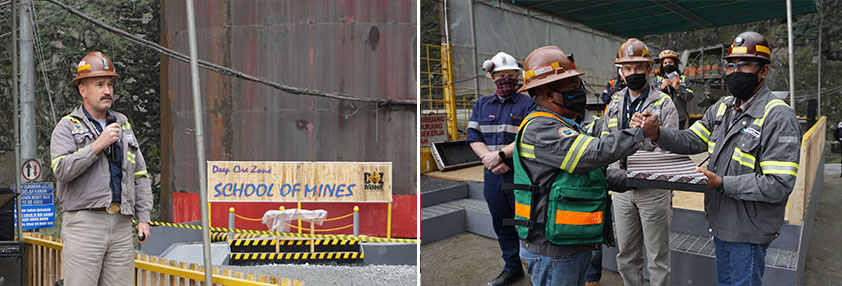PT Freeport Indonesia Retires Historic DOZ Underground Mine

March 14, 2022 – The Deep Ore Zone mine at PT Freeport I, once the heavyweight champion of the world, officially retired in December after a strong run that spanned two decades.
The elder statesman of PT Freeport Indonesia’s current underground family, DOZ retired as planned. This step was driven by the underlying DMLZ cave advance.
At a ceremony held December 8 to recognize the closure of the DOZ, Chris Zimmer, Senior Vice President-Underground Mine at PTFI, lauded the mine next to a sign proclaiming it as PTFI’s “School of Mines” for the teachings in technology and remote operations the mine delivered.
In its sunset years, as is common in many mines, the DOZ was becoming more and more marginal as copper and gold grades were falling and much of the infrastructure was at the end of its service.
“The DOZ mine in its prime was a very big deal and wildly successful on a number of fronts,” said Nick Pascoe, former DOZ Mine Manager.
Wet Muck University
While PTFI’s introduction to operating with wet muck conditions came at the Intermediate Ore Zone mine, which was mined from 1981 to 1994, DOZ was the battleground and university where learnings from wet muck – lots of wet muck, mind you – hyper drove PTFI to the cutting edge of remote operations.
Even at the end of its life, DOZ still had the world’s largest fleet of remote underground operators.
“Grandpa was advanced in age, but he had the most wisdom, even about the newest technology that our other mines – our teenagers – are now using,” said Ardhin Yuniar, Vice President-Geo Engineering at PTFI.
For that reason alone, DOZ continued to be important to PTFI and continued to function as the training ground for remote operations while also continuing to add 20,000 to 30,000 ore tons per day to PTFI’s bottom line.
“During the first two years of the pandemic, when GBC (Grasberg Block Cave) and DMLZ (Deep Mill Level Zone) were ramping up and the pit was gone, having the DOZ to send ore to the mill was particularly valuable,” Pascoe said.
By late 2021, the mine was in semi-retirement and primarily was used to keep a sufficient amount of ore stockpiled to keep the mill fed.
“The last part of 2021, the DOZ was producing around 10,000 tons per day and really was a swing producer that we turned on and off to manage stockpile levels,” Zimmer said. “If stockpile levels were too high, we would turn off the DOZ. If stockpile levels were too low, we would turn it on.”
In its heyday, DOZ produced a lofty 80,000 tons a day and held the title of world’s largest single footprint underground mine, the very title that DMLZ will match and the GBC will exceed by 2023. GBC also is slated to break the record for the fastest ramp-up from breaking ground to peak production in underground mine history, a record that currently belongs to none other than DOZ.
A scripted ending
In DOZ’s case, the factor that led to its closure was not declining ore grade as is most often the case with a mine playing out. In this case, it was all a matter of real estate. DOZ was in the wrong place at the wrong time.
“It was still economic; in fact, the only reason to stop DOZ was the fact that the DMLZ mine overtook it from underneath in 2021,” Pascoe said. “The real issue was the fact that the DMLZ was turning solid rock in to caved rock, so tunnels in the DOZ were literally not there anymore.”
The same process happened years ago when DOZ overtook the Intermediate Ore Zone mine.
“The closure of DOZ was kind of sad, but it was a good thing, because it meant the DMLZ mine was doing well and overtaking it,” Yuniar said. “And GBC is twice as big as DOZ. We’re going to need additional people as both GBC and DMLZ ramp up, so some of the DOZ people already have started moving to the other two.”

Photos (left to right): Chris Zimmer, Senior Vice President- Underground Mine at PTFI, addresses the crowd at a ceremony for the closure of the DOZ Mine at PTFI; Nathaniel Rumaropen (left), one of DOZ's longest-serving employees, gives a souvenir to Carl Tauran, EVP-Site Operations and Technical Mine Manager.



 BACK
BACK
SOCIAL
RECOGNITION